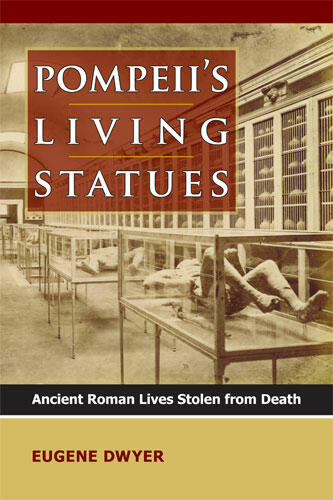Pompeii's Living Statues
Ancient Roman Lives Stolen from Death
An intriguing look at contemporary views regarding the casts of victims from Mt. Vesuvius' eruption
Description
In AD 79, Mt. Vesuvius erupted in two stages. While the first stage was incredibly destructive, it was the second stage, a so-called pyroclastic flow, that inundated Pompeii with a combination of superheated gases, pumice, and rocks, killing tens of thousands of people and animals and burying them in ash and mud.
During excavations of the town in 1863, Giuseppe Fiorelli, the director of the dig, poured plaster of paris into a cavity under the soil revealed by a workman's pick. When the plaster set and the mound was uncovered, all were amazed to see the secret that the ground had held for 1,800 years: a detailed cast of an ancient Pompeian such as no one had seen before, frozen in the instant of dying and complete in every respect, including outlines of the clothes he was wearing at the time of the destruction. The bodies, photographed and exhibited in the specially built Pompeii Museum, completely changed the world's ideas of life in ancient Italy.
Pompeii's Living Statues is a narrative account, supported by contemporary documents, of the remarkable discovery of those ancient victims preserved in the volcanic mud of Vesuvius.
Eugene Dwyer examines these casts and related records, the originals of a number of which (along with their museum) were lost in World War II bombing. As he considers the casts as archaeological and cultural pieces, he also discusses Pompeii and its artifacts in the context of Italian unification and party politics, the development of modern excavation methods, and the challenges of maintaining a very large archaeological site. Dwyer's clear organization and writing style, combined with a collection of photographs and engravings, make for a fascinating exploration of Pompeii and its victims.
Eugene Dwyer is Professor of Art History at Kenyon College. Trained at Harvard and the Institute of Fine Arts at New York University, he has contributed articles to numerous volumes on Italian architecture and archaeology published by presses including Cambridge University Press, Getty Publications, and the University of Michigan Press. He is the author of Pompeian Domestic Sculpture: A Study of Five Pompeian Houses and Their Contents.
Reviews
"Pompeii's Vesuvius victims—as well as the fields of museum studies and archaeology, along with more recent Italian politics—come to life here through plaster casts of those who lost their lives in the eruption of Mount Vesuvius in 79 C.E. Dwyer (art history, Kenyon Coll.) invites the reader to experience the 1861 unification of Italy and what it meant for those working on Pompeian artifacts. While keeping the focus on the statues themselves, formed by pouring plaster into cavities where ancient Pompeians lay amid hardened ash, Dwyer adds information about the era of the eruption, comparative analyses from colleagues in the field, and archaeological and political context to create a holistic scope for deeper understanding of the lives of the victims of Pompeii and the people who brought them back to life. Dwyer thus expands the scope of the lessons from the Pompeii Museum and of general museum studies. VERDICT Scholars and armchair travelers alike will be fascinated by this distinctive book."
—Library Journal
"Written in a lively style with all foreign language texts translated, the book will appeal to readers at all levels."---Choice (Highly Recommended)
"Dwyer's scholarship is sound, his writing engaging."
-- John R. Clarke, University of Texas at Austin, American Journal of Archaeology
"Written in a lively style with all foreign language texts translated, the book will appeal to readers at all levels."
- R. I. Curtis
—Choice (Highly Recommended)
"Dwyer's scholarship is sound, his writing engaging."
- John Clarke
—John R. Clarke, University of Texas at Austin, American Journal of Archaeology
"This delightful volume is a welcome contribution to understanding what made Fiorelli and his methods so important, and to show how intimately archaeological method is linked to political and ideological change."
- A. Wallace-Hadrill
—A. Wallace-Hadrill, Journal of Roman Archaeology
News, Reviews, Interviews
Listen: UMP Author Podcast Series: Eugene Dwyer | MP3 | 6/30/2010
Read: Eugene Dwyer on Fiorelli's Finds | Wonders and Marvels Blog | 8/1/10
Read: Q&A with Eugene Dwyer | PDF | 6/30/2010
Read: Review | Blogging Pompeii | 5/21/2010
Read: Review | Libraryjournal.com | 6/9/2010

